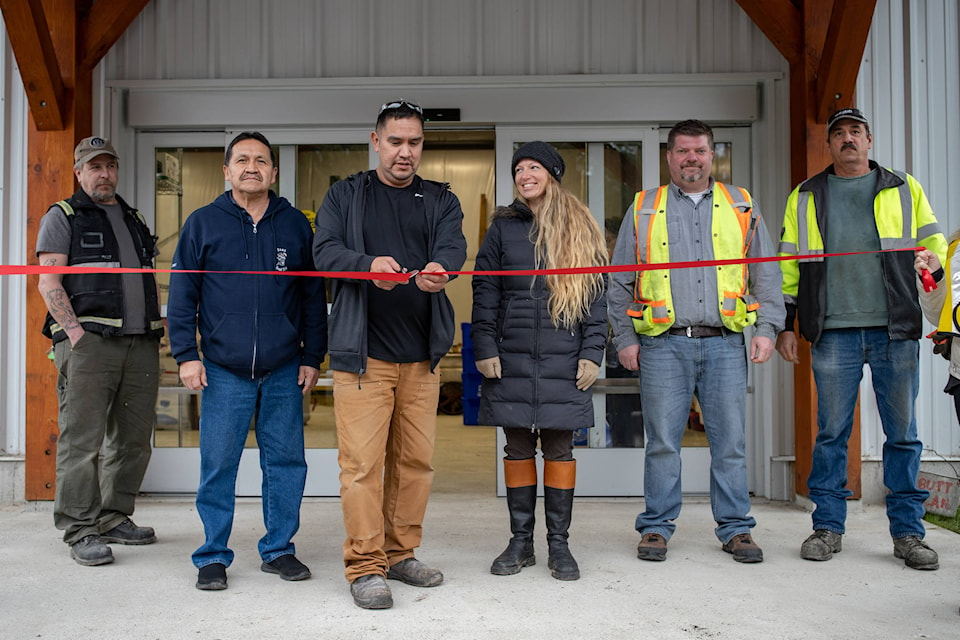Last Saturday saw the “official” opening of the brand-new Thorsen Creek Transfer Station and Recycling Depot. Although it’s been in use for several weeks, the November 24th event was a chance to celebrate how far the community has come in terms of waste management.
“The new depot provides much better access to our recycling options for the community, which means we will now be able to send less waste to the landfill and reduce our community’s impact on the environment,” said CCRD Board Chair Samuel Schooner. “We can now use more of the old site for landfill and can delay having to start shipping waste out of the valley. Road access and the site layout at the new depot is much better which will make life easier and safer for all recyclers; young and old.”
Schooner said the opening is also a celebration of the CCRD’s fifty years of service to the community.
“Waste management is the CCRD’s oldest service, so it’s great that the site has been finished on our Golden Anniversary,” Schooner said.
All community members who visited the depot on that day were given two free recycling bins to help celebrate the event.
The past two boards of the CCRD have made waste management a top priority. In 2013, concerns over maximizing remaining landfill space drove the CCRD Board to allocate significant financial and staff resources to proactively tackle the issue. Several strategies were developed and implemented over the following five years.
Some of those strategies included maximizing recycling opportunities, a new funding agreement between the CCRD and the Nuxalk Nation, hiring a recycling attendant, updating the district’s Solid Waste Management Plan, more education and promotion, the construction of the new depot and transfer station, and decommissioning the old site to free up landfill space.
Space has been a long-standing issue for the landfill since day one. The construction of the new transfer station and the introduction of a comprehensive recycling program has been instrumental in extending the life of the current landfill footprint. McIlwain said the popularity of recycling programs really took off once it was introduced and they quickly came up against the limitations of the old site. Residents are now able to recycle nearly everything in a neat, clean, and orderly environment.
“At the core of CCRD recycling is the printed paper and packaging program. This program was rolled out province wide in 2014 and is responsible for about 90 percent of what is sent out monthly for recycling,” said Ken McIlwain, CCRD Public Works Manager. “This program basically covers any kind of packaging material (cans, jars, plastics, cardboard) as well as printed paper like catalogues and phone books and junk mail. This program made it possible to hire an attendant and sign on for all the other recycling programs, ranging from small appliances to tires to light bulbs to used oil.”
The bulk of the funding for the project came came from the Federal Gas Tax-Community Works Fund, with additional capital funds coming from the solid waste management budget. Funding was also provided by the BC Used Oil Management Association for the purchase of storage tanks and modified sea-cans.
BC Hydro provided the funding for the trees and shrubs planted around the new site. The total cost of the project is in the neighborhood of $1 million.
The new site is close to the landfill but features an entirely different design than its counterpart. It is designed to facilitate one-way traffic, as congestion was a key problem at the former site.
In addition, it is designed to offer waste diversion as the first opportunity.
“We want people to achieve the mindset that they are going to get rid of almost everything from their vehicle, before they finally arrive at the green dumpsters to drop their non-recyclable waste,” said McIlwain. “The green bins get landfilled, and that should be the very last option.”
That being said, the recycling facilities are now designed to make the experience as pleasant as possible. The building is spacious and open, featuring sliding glass doors, good lighting, and heat. A recycling attendant is always on hand to help residents with any questions.
There has been a bit of a learning curve as residents figure out the new system, but McIlwain said overall things are going very well.
“We have noticed that customers are used to disposing of their garbage first and then dealing with recyclables. This is a mindset left over from the old site where that approach made more sense,” he said. “We are encouraging the public to keep in mind that the site is designed to be one-way, and it will make it easier for everyone if people get rid of their recyclables first and save the garbage to last.”
